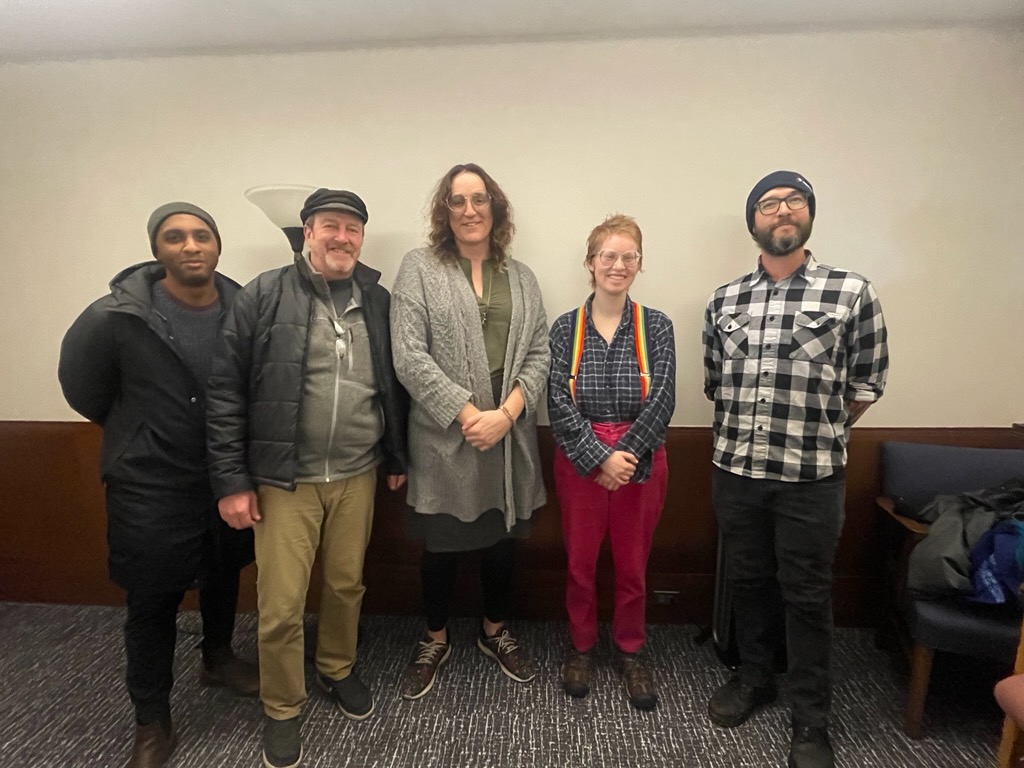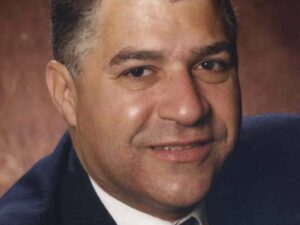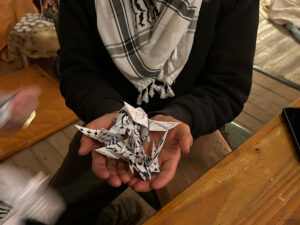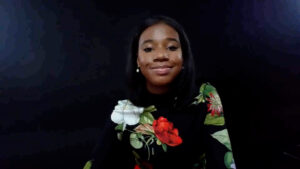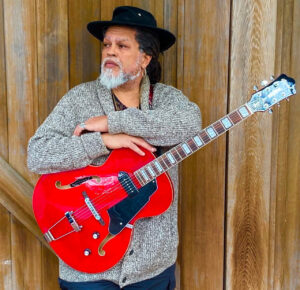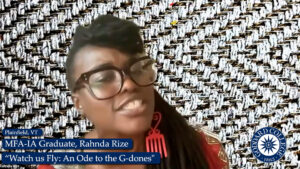
by Karla Haas Moskowitz, PhD
As individuals and communities navigate their own sense of power, how and when stories are released into the world become critical forces that shape quests for both protection and influence. As activists and storytellers, our knowing what to say, when to say it, and to whom becomes pivotal in our work to save our world, and ourselves.
Goddard’s conversations with the world manifest in the powerful stories that we hear, share, and create. Goddard-generated and facilitated stories have risen from places throughout the globe and span disciplines, genres, and experience. They are born from spontaneity and wielded through generations of engagement. Goddard stories reveal faculty, students, and alumni as shape-shifters in a world seeking revelation.
In fact, one could conclude that Goddard is a story-center. It appears that story is our vehicle as we transcend difference, indifference, and relational barriers that may otherwise seem impenetrable.
Maxine Greene shares: “Even in the small, the local places in which teaching is done, educators may begin creating the kinds of situations where, at the very least, students will begin telling the stories of what they are seeking, what they know and might not yet know, exchanging stories with others grounded in other landscapes, at once bringing something into being that is in-between. It is at moments like these that persons begin to recognize each other and, in the experience of recognition, feel the need to take responsibility for each other.”1
Goddard promotes this sense of responsibility in its mission as well as in the curriculum it facilitates across the college. A Goddard student learns immediately upon his or her arrival at residency that authentic learning insists and incorporates an ability to respond to self, others, and the earth in ways that promote sustainability and justice. Story sharing is a critical component in this.
A work of literary criticism, ‘The Corn People Have a Song, Too. It is Very Good,” by J. Edward Chamberlin, begins with a poem originally traced to the Pueblo people of North America: “the corn people have a song too/it is very good/I refuse to tell it.”2 In this article, Chamberlin notes the power of literature to provide, among other things, a doorway to trickery and magic as well as a window into truth and beauty. Explored here is the notion that stories can be given, and then there is light; stories can also be withheld and with this there may be darkness, a black void of silence that may incite as well as confuse. Yet, no matter how stories are used, they have the potential to brandish power and reveal sacred meaning. In this way, story can be the talisman, for a community like Goddard, to uphold its standard and express its power to have a place in the world and to shape this world in magical and essential ways.
Chamberlain explores that while stories may bring people together, they may also pull them apart; but possibilities of cohesion and divisiveness are the chances we take when sharing the various storylines of our lives. This is especially the case when we employ narratives to help construct the critical change we seek inside and outside of ourselves.
Engaging in storytelling as a way to both converse with one another and to express our activism, crafts, in Chamberlain words, “material and spiritual agency,” thus bringing people together into community.
At Goddard, we align with the power of story to position ourselves, explicitly, as a community where narrative and people come together in the name of activism. The conversations Goddard has with the world are created with intention to express radical acts to transform and to transgress. These stories are evidence of infusion and inspiration within communities across the globe revealing the interdisciplinarity, passion, and artistry needed to promote righteousness and equity.
“Goddard is, at its heart, about learning how to live, which necessitates a continual conversation with ourselves about what it means to be a good citizen locally and globally,” says Caryn Mirriam-Goldberg, founder of the Transformative Language Arts (TLA) program and acting director of the Goddard Graduate Institute (GGI). “What does it mean to positively contribute to our communities in concert with the realities and possibilities inherent…at the moment? How do we take good care of ourselves, and others, while pursuing what calls to us in our work, activism, art, and studies? These are lifelong questions that tilt us toward widening our perception beyond our biases, limitations, and ideas about the world to see, as clearly as we can, what’s happening now. To see, to take action, and to work in community…all takes courage, vision, and willingness to dwell in not knowing until we find our best ways forward, and, in that movement forward…make a new story out of how we live.”
Our Goddard community is so thoroughly engaged in creating new stories and paradigms for living, they couldn’t possibly fit into the too few pages of this article. Below is a brief list of Goddard people with a synopsis of their storytelling and activism work.
Story voice: transformation, healing, and evaluation of self and others
Kerrie Lynn Mayer (MA EDU ‘13) asks, “How does one become a teller of stories, a speaker of truths, a confronter of fears and injustices?” in her Goddard thesis, titled “Self-Transformation and Collective Liberation: Stories of Learning and Longing.” Mayer articulates the importance of stories and the ways they connect us. She discovers how her own “storylessness” kept her silent. In telling her own story, Mayer realizes “I want to be a voice for change, a voice that names fear, a voice that speaks up,” she writes.
Erin Katherine Johnson (MA EDU ’12) engaged in a “learning to learn” process that emerged from the stories of her own life in her thesis, “Wandering to Know: A Cyclical Study of Fear and Story, or Skating Circles Around Myself: A Heuristic Exploration of Storytelling and Fear.” She collected personal narratives and documented the origins of and processes of fear on her blog.
Robin Stone (MA HAS ‘15) used her graduate thesis “Black Women’s Lives Matter: A Narrative, Womanist Approach to Self-Care,” as a vehicle “to help Black women embrace self-care through engaging with the stories of their bodies,” she says. Her final product was the production of a documentary along with a writing workshop to “expand the power of narrative…to turn story receivers into storytellers.”
Meta Commerse (BA HAS ‘01, MA EDU ‘02, MFAW ‘11) has founded a community-based intervention project called Story Medicine (storymedicineasheville.com), that publishes books and videos and gives workshops and presentations on using the power of story to heal.
Story threads: connection and collaboration
Poet Gale Jackson (MFAIA faculty) has helped develop Storyteller in Residence / Poet in the House Collaborative for public school students in New York City. Says one of her middle-school-aged students, “The Poet in the House Collaborative is very important to me. Through Professor Jackson’s teachings, I learn to think more deeply about who I am and about the world around me.”
Deborah Hickey’s (MA PSY faculty) creative research has contributed to the development of Artful & Playful Expressions of Genograms, a workshop shared at the Expressive Summit in New York City. Hickey engages participants in one of several mediums of artful/playful genograms that include: animal genograms; mythology genograms; mapping genograms; and sculpturing.
Karen Werner (UGP Faculty) and Kristi Leora Gansworth (MFAW-WA‘12) are collaborating on an audio and digital storytelling project currently entitled, “I Have Been Born at the Waterfall Many Times.” The piece is about decolonization and water as a living relative, focusing on sacred waterfalls, Akikodjiwan (Chaudière), that are part of a proposed real estate development in the center of Ottawa, Ontario. The project wa commissioned by the academic journal Rethinking Marxism for their Winter 2016 issue on Marxism and spirituality.
Story documentation: personal, political, fight against oppression
Micheline Aharonian Marcom (MFAW faculty) is helping to put a human face to the immigration crisis by working on an oral history project called The New American Story Project (newamericanstoryproject.org), where she will document the real stories—turning statistics into narratives—of undocumented men, women and children living in the U.S. Marcom has already captured the stories of a dozen unaccompanied Central American minors living in Oakland, California.
Michele Clark (MA PSY faculty) started a story-based blog about being Jewish on the Lower East Side from 1945 to 1960. She writes about her experience as a New York Jew and historian of family, community, and meat (rivingtonatessex.blogspot.com).
Matthew Dineen (IMA ’14) shares a passion with Scott Nikolas Nappalos, editor of Lines of Work: Stories of Jobs and Resistance, who writes: “Working class experiences of story telling have not been taken seriously enough among those of us who try to organize and build a better society…. The lives of working class people are filled with stories…about their struggles, perspectives, and aspirations…The act of telling our tales of work and struggle can change people.” Dineen created The Music & Work Project, which includes a zine, blog, and nationwide tour exploring the role of music in our working lives (themusicandworkproject.blogspot.com).
From his one-bedroom apartment in Denver, Colorado, Mark Anderson (IBA ’14) created a podcast, The Smallest Bone: bringing what’s outside, inside, for his senior study (thesmallestbone.com). “The smallest bone in the body is located in the middle ear,” says Anderson. “It plays an integral part in the human process of hearing by conducting sound waves to the inner ear.” In the same way the smallest bone transmits sound into meaning, Mark offers a look into his own family history with these family interviews interspersed with music and commentary.
Story map: place as story
Wendy Call (BFAW faculty) recently launched a map/place-based literary project that contains a collection of Sqebeqsed Stories, the stories of Southeast Seattle’s Seward Park, home to the city’s last old-growth forest (sewardparkstories.org).
Story teaching: youth rising up
True Stories: Adventures in Nonfiction Audio Storytelling, conceptualized by Karen Werner (UGP Faculty) in collaboration with Jackie Batten (WGDR Training Coordinator), is a semester-long, dual-enrollment program at Goddard available to local high school students who immerse themselves in the art of telling true stories through sound, deep listening, and various forms of audio storytelling.
Story agency: conversation and change in a world reaching for justice
Loba Wakinyan Azul (MFAW student) started a conversation at the MFAW Port Townsend residency about diversity and Goddard’s responsibility as a community to “make what we offer available to a broader racial community.”
Susan Sakash (MA SIS ‘15), moments before her commencement at Goddard, organized four and a half minutes of silence as part of the nationwide remembrance of Michael Brown. Her graduate work, “The Solidarity Economy as Social Innovation,” unpacked “the solidarity economy framework” and “economic democracy” by grounding them in individual/collective visions of what a more just and ethical economy looks and feels like.
Amoshaun Toft (BA RUP ’00) is an educator, researcher, and activist who studies and teaches “about language, power, and social change” at the School of Interdisciplinary Arts and Sciences at UW Bothell. Toft analyzes public dialog about social movements and works with activists on storytelling strategies that can effectively engage with the existing stories to change them and thus public policy.
Doyle Canning (BA EDU ‘03) co–wrote Re-Imagining Change: How to Use Story-Based Strategy to Win Campaigns, Build Movements, and Change the World (PM Press, 2010), and co-founded the Center for Story Based Strategy (storybasedstrategy.org). Both are tools that teach one to harness the power of narrative for social change, how to change the story to enact change.
These stories about alumni, students and faculty and their, and therefore Goddard’s, work in the world to keep activism alive is only the tip of the iceberg. The ones mentioned here expose the epidermis of the humanity that is inherent in the College’s efforts to live its mission.
Acclaimed author Sue Monk Kidd wisely warns us that “stories have to be told or they die, and when they die, we can’t remember who we are or why we’re here.” Goddard’s brand of local and global activism is fueled by a notion that links stories to truth-telling, and truth-telling to justice. So, yes, stories are being told; and, yes, they have to be told. In fact, our lives depend on it. These stories inspire and activate changes in self and in society that may not be easy to witness; but it remains irrefutable that the College’s story-infused activism lives on.
1Greene, Maxine. “Diversity and Inclusion: Toward a Curriculum for Human Beings.” Teachers College Record Winter 95.2 (1993): 211-21.
2 Chamberlin, J. Edward. “”The Corn People Have a Song Too. It Is Very Good”: On Beauty, Truth, and Goodness.” Studies in American Indian Literatures 21.3 (2009): 66-89.
This article originally appeared in Clockworks Magazine in 2015.

